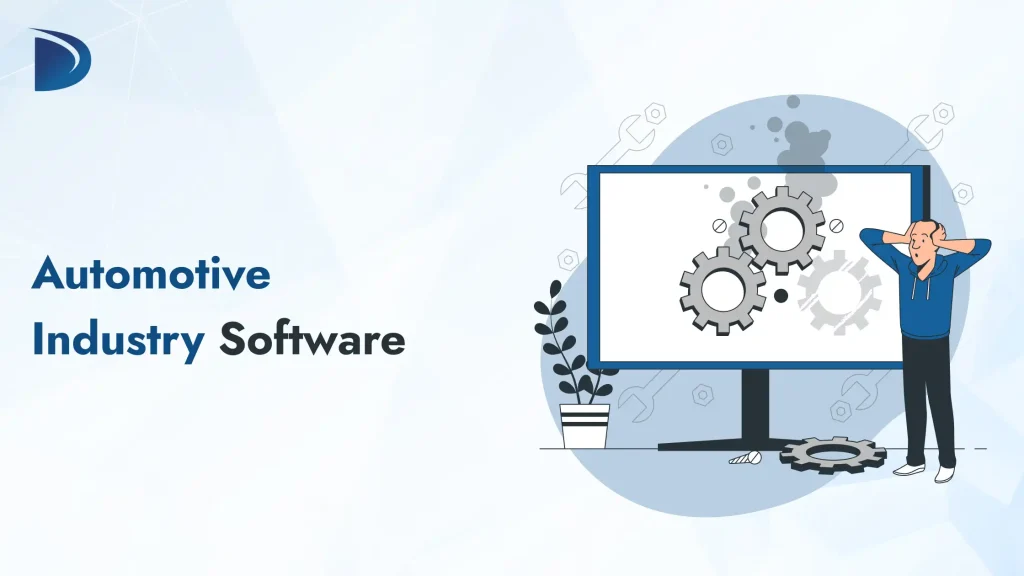Table of Contents
Automotive industry software is now at the center of how vehicles are built, operated, and managed. It supports everything from design and production to diagnostics, across cars, trucks, buses, and more.
It’s not just about code behind the wheel. This software helps companies work faster, build safer machines, and serve drivers better. Whether it’s in a factory or on the road, software shapes how the entire industry works.
This blog breaks down what it is, why it’s used, and how it helps both businesses and drivers.
What is Automotive Industry Software?
Automotive industry software includes all the digital tools used across the vehicle sector. It covers planning, design, production, performance, and after-sales support. The software works in both the machines we drive and the systems businesses use behind the scenes.
From tracking inventory in a factory to controlling safety systems inside a truck, this software plays a part at every stage. Many companies now depend on automobile software systems to manage everything from orders to repairs.
On the road, vehicle software solutions help monitor engine health, control braking, manage emissions, and support features like navigation or driver alerts. It’s the digital support system behind how vehicles run and how companies keep things moving.
Why Is Automotive Software So Important?
You might wonder why all this software is such a big deal. The truth is, modern vehicles just can’t work without it. Think about the many things vehicles do today. From keeping us safe to helping businesses track their fleets, software makes it all possible.
It’s not just about adding cool new features. Software is now a basic part of how vehicles are made and how they run. It helps every part of the vehicle industry work better. Automotive Software Development has become a very important job, because new programs are always needed for better safety, more comfort, and smarter ways to manage vehicles.
Here are a few reasons why this software is so needed:
For Smarter, Safer Drives: Software makes vehicle safety features work. Examples include lane warnings or automatic braking in cars and trucks. These systems need exact software to help keep everyone safe.
To Build Vehicles Better and Faster: Software helps design new parts. It also controls robots on the factory floor. This makes building vehicles quicker and with fewer mistakes.
To Manage Fleets and Businesses: For companies with many vehicles, software is key. Vehicle management software helps them track every truck or bus. They can see locations, fuel use, and service needs. This helps companies save money and keep vehicles running.
For New Features and Updates: Just like your phone gets updates, vehicles can now get new features or fixes through software. This means a vehicle can get better over time without going to a service center.
To Handle Green Goals: Vehicles need to use less fuel or produce fewer harmful gases. Electric vehicles especially rely on software for battery and power use. This helps vehicles meet rules for a cleaner world.
Where and How Automotive Software Is Used
Car Manufacturing Software
Every car goes through hundreds of steps before it’s complete. Car manufacturing software keeps production steady by managing machines, tracking each part, and helping teams fix problems early.
- Controls machines across production stages
- Follows parts through each build step
- Finds issues before they slow down work
Manufacturing Software Development
Before anything is built, the design needs to be right. Manufacturing software development supports teams in testing and adjusting digital models, so fewer mistakes happen during real production.
- Builds and edits designs on-screen
- Speeds up updates and part testing
- Cuts costs by reducing physical trial runs
Automotive Enterprise Software
Vehicle companies work across many departments, from supply chains to customer service. Automotive enterprise software brings all of this together, making it easier to plan and run daily tasks across the business.
- Connects data across departments
- Keeps track of orders and stock levels
- Helps teams stay on the same page
Who Gains from Automotive Industry Software in Real Use Case
Automotive software helps every part of the vehicle world run better. Whether you’re building, buying, selling, or managing vehicles, the right tools make a big difference.
Consumers
Drivers now expect more from their vehicles. Thanks to automotive system software, cars come with better safety, smart alerts, and entertainment features that are easy to use. Updates can also be made without visiting a service center.
- Safer drives through active safety tools
- Smarter features like voice navigation and alerts
- Easy updates to fix bugs or add new functions
Car Manufacturers
Car makers use vehicle production software to plan, test, and build. From early design to factory control, software helps create better vehicles faster, with fewer errors and less waste.
- Faster design changes and part testing
- Real-time control of factory tools and materials
- Lower costs with less manual rework
Dealerships and Service Centers
Software that car dealerships use goes beyond inventory. It helps with sales tracking, service bookings, and customer support. Mechanics also rely on digital tools to run vehicle diagnostics and find faults quickly.
- Track sales, service history, and customer data
- Book services and repairs more easily
- Run diagnostics to find and fix issues faster
Fleet Operators
Fleet managers need to keep many vehicles running at once. Automotive software helps track usage, plan maintenance, and avoid downtime. It also helps reduce fuel waste and spot problems before they get worse.
- Track location, fuel use, and health of each vehicle
- Plan regular servicing to avoid costly repairs
- Keep operations smooth with fewer disruptions
Technology Teams
Car technology platforms give engineers and IT teams a common base to build on. These platforms help connect new features, manage software updates, and test changes before they’re rolled out.
- Build and connect apps and tools in one place
- Share data safely between systems
- Speed up new feature development
Emerging Trends in Automotive Industry Software
Vehicle software is changing fast. It’s now part of how cars are built, how they run, and how updates are handled over time. These changes are shaping the future of the auto industry.
Software-Defined Vehicles (SDVs)
Your car can now get better with time. Thanks to SDVs, updates don’t need a trip to the workshop. New features, better control, and bug fixes can all be sent straight to the vehicle, just like a phone update.
Artificial Intelligence (AI)
Cars are learning how to think ahead. AI powers smart driving features, spots problems before they happen, and even adjusts settings based on your habits. It’s helping make every ride smoother and safer.
Electric Vehicles (EVs)
Behind every EV is smart software doing the hard work. It manages the battery, balances power during drives, and helps stretch each charge further. That means more distance, less stress, and better performance on the road.
Cybersecurity That Keeps Cars Safe
With all this tech, protection matters more than ever. Today’s vehicles use security software to block hacks, guard your data, and make sure everything from braking to navigation stays safe and stable.
Tech Tools Behind Modern Auto Industry Applications
| Auto Industry Applications | Automotive Tech Tools |
| Vehicle Design | SolidWorks, CATIA, MATLAB |
| Control Systems & Simulation | Simulink, AUTOSAR, QNX |
| Manufacturing & Testing | CANoe, CANalyzer, LabVIEW |
| In-Vehicle Infotainment | Android Automotive, Apple CarPlay |
| Vehicle Diagnostics & Maintenance | OBD-II Scanners, Bosch ESI[tronic], Jaltest |
| Fleet Management | Geotab, Samsara, Verizon Connect |
Conclusion
Automotive industry software is now a part of everything from design to driving. It helps businesses work smarter, keeps vehicles running smoothly, and adds useful features for drivers. As vehicles become more connected and complex, the right tools and systems keep things simple, safe, and up to date without extra effort.

